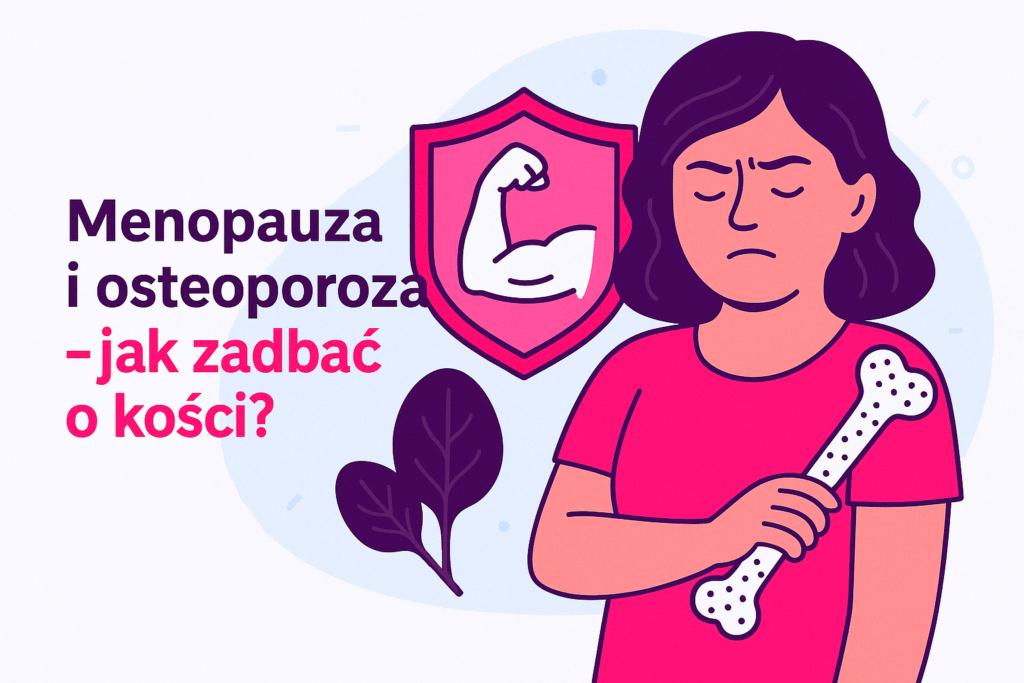Osteoporosis is one of the most serious yet often underestimated health risks for postmenopausal women. It is estimated that as many as 1 in 3 women over the age of 50 will suffer a fracture due to this condition¹. The main cause is a sudden drop in estrogen levels, which affects bone metabolism. Fortunately, osteoporosis can be effectively prevented through diet, exercise, supplementation, and informed lifestyle choices.
What is osteoporosis and why does menopause accelerate its development?
Osteoporosis is a disease characterized by reduced bone mineral density and disrupted bone microarchitecture, leading to an increased risk of fractures—especially in the spine, hips, and wrists².
Estrogens:
- inhibit bone tissue resorption (breakdown)
- stimulate collagen production in bones
- support osteoblast activity (bone-forming cells)
During menopause, the drop in estrogen levels leads to accelerated bone loss, which may reach 3–5% annually in the first years after menopause³.
Who is most at risk of osteoporosis?
The risk of osteoporosis increases in women who:
- enter menopause before age 45 (naturally or surgically)
- have low body weight and a small frame
- have a family history of osteoporotic fractures
- smoke and/or consume alcohol
- avoid sunlight or have low vitamin D levels
- lead a sedentary lifestyle
- have hypothyroidism, celiac disease, or rheumatoid arthritis
- have taken long-term glucocorticoids
How to prevent osteoporosis after menopause?
1. Ensure a diet rich in calcium and vitamin D
Calcium: recommended daily intake after menopause is 1200–1500 mg
Sources: milk, yogurt, cheese, tofu, kale, sesame seeds, almonds, calcium-rich mineral water
Vitamin D: improves calcium absorption and regulates bone metabolism
Recommended supplementation: 2000–4000 IU/day, especially during months with little sun⁴
Protein: supports bone tissue rebuilding – about 1 g protein/kg of body weight is recommended
Magnesium, zinc, vitamin K2: support calcium metabolism
2. Exercise regularly – preferably with resistance
- Resistance and strength training stimulate bone formation
- Balance training (e.g., tai chi, yoga) reduces fall risk
- Walking, Nordic walking, dancing – improve bone density in hips and spine
- 30 minutes of activity 5x per week can significantly reduce fracture risk⁵
3. Avoid factors that accelerate bone loss
- Limit alcohol and caffeine (consumption of >3 cups of coffee per day may reduce calcium absorption)
- Quit smoking – nicotine impairs osteoblast function
- Limit salt – excess intake increases calcium excretion in urine
4. Consider diagnostics and supplementation
- DXA scan (densitometry) assesses bone mineral density (T-score)
- Calcium and vitamin D supplementation – especially for women not consuming dairy
- Collagen, soy isoflavones, boron, silicon – may support bone health, though evidence is limited⁶
5. Osteoporosis medications – when are they necessary?
In cases of diagnosed osteoporosis or low-energy fractures, a doctor may recommend pharmacological treatment, such as:
- bisphosphonates (alendronate, risedronate) – inhibit bone resorption
- denosumab – monoclonal antibody that blocks resorption
- raloxifene – selective estrogen receptor modulator (SERM)
- HRT – effective for preventing bone loss in women under 60, but not recommended solely for osteoporosis treatment
Symptoms and effects of osteoporosis – often noticed too late
Osteoporosis develops silently. Its first sign is often:
- a fracture from a minor trauma (e.g., a fall from standing height)
- height loss (up to 3–5 cm)
- back pain, stooped posture, difficulty standing upright
Every woman over the age of 50 should undergo at least one bone density test.
Menopause is a critical time for bone health. While bone loss is a natural process, it does not have to lead to osteoporosis and fractures. Regular physical activity, a calcium- and vitamin D-rich diet, avoiding harmful habits, and preventive screenings can significantly reduce the risk of serious complications. The earlier you start prevention, the better—strong bones are the foundation of mobility and independence in later life.
References
- Kanis JA et al. European guidance for the diagnosis and management of osteoporosis in postmenopausal women. Osteoporos Int. 2019.
- NIH Osteoporosis and Related Bone Diseases National Resource Center. What Is Osteoporosis?
- Riggs BL et al. The pathogenesis of osteoporosis. Endocr Rev. 2002.
- Holick MF. Vitamin D deficiency. N Engl J Med. 2007.
- Howe TE et al. Exercise for preventing and treating osteoporosis in postmenopausal women. Cochrane Database Syst Rev. 2011.
- Zdzieblik D et al. Oral supplementation with specific collagen peptides improves bone mineral density and bone markers in postmenopausal women with osteopenia. Nutrients. 2017.

